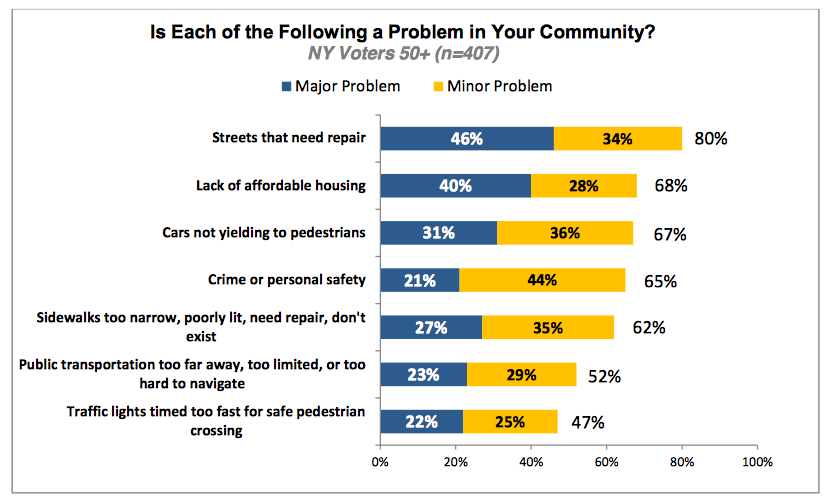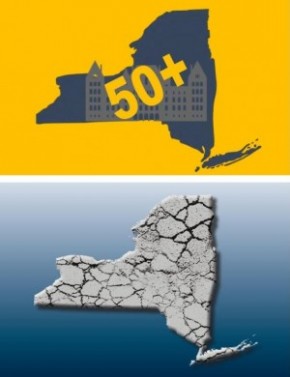
Back-to-back reports released this week by AARP and the New York State Comptroller take two different approaches to arrive at the same conclusion: New York’s infrastructure needs are not being met.
AARP’s report, 2014 State of the 50+ in New York State, surveyed New Yorkers aged 50 and older to determine their likelihood of staying in New York after retirement, and what factors would impact that decision. The survey revealed that:
- 60 percent are at least somewhat likely to leave New York after retiring; 27 percent extremely likely
- 66 percent would be more likely to stay if improvements were made to transportation
- 80 percent identified “streets that need repair” as a problem in their community
- 67 percent cited cars not yielding to pedestrians as a problem in their community
- 52 percent said public transportation was too far away, too limited or too hard to navigate
- 67 percent said they would “vote for a candidate working on maintaining safe and independent mobility around town”
Unfortunately, according to NYS Comptroller Thomas DiNapoli’s report, “Growing Cracks in the Foundation,” instead of taking steps to improve the situation, local governments are actually cutting back on capital spending for infrastructure. The report shows that between 2010 and 2012 there has been a reduction of nearly 8 percent in spending on roads, bridges and water and sewer systems in New York. The lack of spending on sewer and water systems was particularly significant: during the same time period, localities spent 35 percent less on water and 10 percent less on sewer systems, a concerning statistic given the recent diversion of sewer and water funds for New New York Bridge related projects. The report estimates that in order to stay on top of deteriorating infrastructure, communities should be spending $3.9 billion a year; at the moment, they’re spending about one-third of that, or $1.2 billion.
The identified causes for this reduced investment include reductions from the federal American Recovery and Reinvestment Act, rising costs of raw materials like asphalt and steel, New York’s property tax cap, and the costs associated with storm recovery, which have resulted in cuts to routine maintenance.
Local communities can get ahead by establishing local implementation funds for complete streets, as was done in Suffolk County, but Albany also needs to play their part. The legislature and Governor will need to secure adequate and sustainable funding streams, and not rely on one-shots or increased borrowing, to fully fund the upcoming five-year capital plans for both NYSDOT and the MTA, both of which are key to building livable communities—with safer streets and better transit—for seniors.


We have the highest state and local tax burden in the U.S., as a percent of income. Even so, our infrastructure investment is low. Where does the money go?
Debts run up by today’s seniors. Retroactive pension increases for retired and soon to retire public employees. Underfunding of those increases for years, to hide their cost, causing the future burden to soar. And sky high Medicaid spending compared with other places, on seniors.
To top it all off, public employee pension income is exempt from state and local income taxes, at any age up to any amount. Private sector workers get a $20,000 per year exemption, and the AARP is pushing for all seniors to pay no state and local income taxes, shifting the soaring burden to everyone else.
Those who have more keep taking more and more.
http://larrylittlefield.wordpress.com/2014/08/10/generational-equity-and-the-legacy-of-todays-politicians-update/
Hey AARP members: don’t let the door hit you in the ass on the way out.
Good piece. I can’t help thinking of Joe the Planner’s article about Buffalo, with the evocative sub-head midway through the article: “Same Number of People. Three Times the Stuff”. The “3x the Stuff” being the sprawled out roads, pipelines, and other infrastructure that the same number of people need to pay to maintain.
http://joeplanner.blogspot.com/2010/02/sprawl-and-r-word-buffalo-niagara-case.html
[…] DiNapoli: Cities in NY Spending Less Than a Third of What’s Needed for Infra Upkeep (MTR, Crain’s) […]